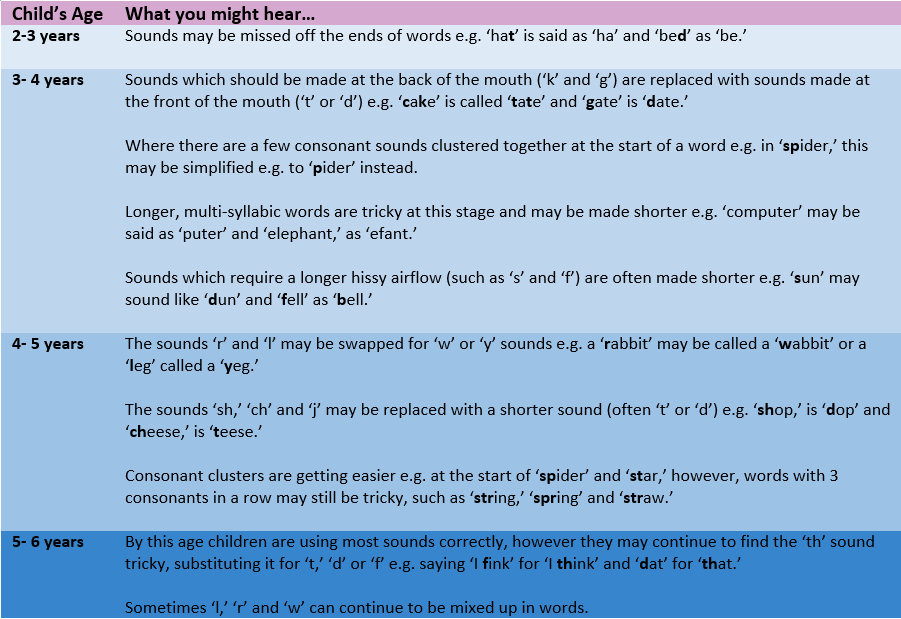Speech Sounds
Aberdeen City Health and Social Care Partnership
What are speech sound difficulties?
Some children have difficulty developing speech sounds and may know lots of words and be using sentences, but his/her speech may be hard to understand. Children with speech sound difficulties may substitute sounds in a word (eg. producing ‘Cat’ as ‘Tat’ or ‘Fish’ as ‘Bish’), they may leave sounds out of words (eg. house – ‘hou’) or may be unable to say or copy sounds. Some children may be able to say a sound on its own but they are not able to put it into a word correctly. When a child has difficulty with speech sounds it may be hard for a listener to understand what they are saying e.g. ‘a cup of tea’ may sound like ‘a tup of tea.’
When should I be worried?
Children learn how to produce speech sounds gradually and at different rates to each other. You might be able to understand your own child’s speech, but unfamiliar adults or other children might find it difficult to understand them.
For most children:
Speech should be approximately 25% intelligible by 18 months.
Speech should be approximately 50-75% intelligible by 36 months.
Speech should be approximately 100% intelligible to both familiar and unfamiliar listeners by 37-48 months.
As children learn to talk, some sounds are developed earlier (like ‘m’ and ‘b’) and some develop later (like ‘r’ and ‘th’). The pyramid below shows the average age that most children (approximately 90%) use each sound correctly. In addition, the table below shows typical error patterns children make when learning to talk, as they simplify adult speech. For some children, these error patterns may persist over time, or they present with more significant difficulties with their speech sound development and support from a Speech and Language Therapist will be required.
In addition to typical developmental norms, there are many other factors which influence the targets a Speech and Language Therapist chooses to work on, and when they choose to do this. It is important to consider the child’s motivation to engage in therapy, what sounds are meaningful to them and how any errors are impacting on their confidence. For example, if a child cannot say their name clearly, these sounds may become a focus in therapy.


References: Bowen, C. (1998). Developmental phonological disorders. A practical guide for families and teachers. Melbourne: ACER Press. / McLeod, S., & Crowe, K. (2018). Children’s consonant acquisition in 27 languages: A cross-linguistic review. American Journal of Speech-Language Pathology, 27, 1546–1571. doi:10.1044/2018_AJSLP-17-0100
How Can I Help?
> React to what your child says; not how clearly they speak: this lets your child know you value what they are saying. Try to avoid correcting your child as this can be confusing if your child does not yet realise they are mispronouncing words.
> Repeat what your child says using the correct production: when you repeat words correctly, you are letting your child know that you know what they mean but ‘this is how you say it’. For example, if your child says ‘I see a tat’, you could say ‘I see a cat, too! It’s a fluffy cat’.
> Don’t make your child repeat words: drawing too much attention to mispronunciations and making children repeat words is not helpful and can impact on a child’s confidence communicating.
> Try playing word games to help your child listen to the sounds around them: singing nursery rhymes together, clapping out the number of syllables in longer words, reading rhyming books (like Dr Seuss’ Fox in Socks) and going on listening walks (to listen for ambulances, trees moving in the wind and birds chirping) are some of our favourite ways to listen out for sounds!.
Speech Sound Development Video Series
These videos are for you if you are interested in learning more about children’s speech sound development or if you are the parent or carer of a child whose talking can be tricky to understand or who you feel may not be using the full range of speech sounds. These videos are also appropriate for Health Visitors, Early Years Practitioners and teachers.
In the first video, we think about the typical development of speech sounds and what is meant by speech sound processes (mixing up or missing out sounds in words).
In the second video we introduce some strategies you can use in everyday situations to help support speech sound development and to help you know what to do if you haven’t understood what your child has said. We’ll also share some ideas for games and activities you can try with your child to help develop their speech sound awareness.
An Introduction to Speech Sound Development
How To Help Your Child’s Speech Sound Development

Trusted Websites and Resources
https://ican.org.uk/media/1278/speech-sounds-factsheet.pdf
The bookbug app is freely available on android or apple and has a large library of songs with videos in a number of languages. Some videos are animated and others are a real life recording suiting different learning styles and age/stage of development.

